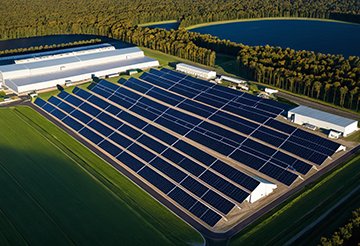Published: July 20, 2015 | Updated: September 18, 2025
Published: July 20, 2015 | Updated: September 18, 2025
Powering the Future: CMMS for Enhanced Solar Energy Management
 The narrative surrounding solar power experienced a fascinating trajectory. Once a constant topic of discussion heralded as a primary energy alternative capable of powering everything from individual dwellings to entire transportation networks, its prominence in daily news cycles seemingly receded. This shift, however, does not indicate a decline in its significance. Instead, while various alternative energy sources garner attention, solar energy quietly and steadily integrates itself into numerous facets of modern life. The question then arises: what became of this initially celebrated "free" power source? How does it currently contribute, and what prospects does the future hold? Let's explore solar for powering the future and the role of computerized maintenance management system (CMMS) for enhanced solar energy management.
The narrative surrounding solar power experienced a fascinating trajectory. Once a constant topic of discussion heralded as a primary energy alternative capable of powering everything from individual dwellings to entire transportation networks, its prominence in daily news cycles seemingly receded. This shift, however, does not indicate a decline in its significance. Instead, while various alternative energy sources garner attention, solar energy quietly and steadily integrates itself into numerous facets of modern life. The question then arises: what became of this initially celebrated "free" power source? How does it currently contribute, and what prospects does the future hold? Let's explore solar for powering the future and the role of computerized maintenance management system (CMMS) for enhanced solar energy management.
The utilization of solar power boasts a surprisingly long history, with rudimentary applications dating back to the 7th century, primarily for the generation of fire. However, the practical, contemporary understanding of harnessing solar energy and converting it into a usable form emerged in the 1960s. A pivotal moment arrived with Bell Labs' invention of the first silicon-based photovoltaic solar cell. This groundbreaking innovation laid the foundation, but it required another decade of refinement before these solar cells achieved commercial viability and began their gradual entry into the marketplace.
The fundamental principle behind all solar panels involves capturing sunlight and transforming it into a useful energy format. Solar thermal panels achieve this by employing sunlight to heat water, which finds applications in cleaning processes and general water warming. Conversely, solar photovoltaic (PV) panels, the more commonly recognized type, directly convert solar energy into electricity, a process familiar to most individuals.
Modern Applications of Solar Technology Across Industries
Today, solar power demonstrates its versatility through a wide array of applications spanning diverse industries. One of the most straightforward and ubiquitous uses appears in lighting solutions. Illuminated pathways and gardens, now commonplace in residential areas after dark, often rely on solar power. Instead of drawing electricity from traditional extension cords, these outdoor lighting systems typically incorporate small solar panels that gather energy during daylight hours, subsequently powering LED lights at night.
Expanding in scale, many homeowners now choose to power their entire residences with solar energy. These systems utilize arrays of solar panels to capture sunlight, which then undergoes a series of conversions to become alternating current (AC) power, suitable for operating all household lights and appliances. This adoption signifies a growing trend towards energy independence and reduced reliance on conventional power grids.
Beyond residential applications, solar power has made significant strides in transportation. The ambitious Solar Impulse project, an airplane designed to circumnavigate the globe without any fuel, captured global attention. Although the aircraft experienced a temporary grounding due to technical considerations before completing its journey, it undeniably demonstrated the potential of solar technology to revolutionize the transportation and aviation sectors, pushing the boundaries of what is currently considered possible.
The Future Trajectory of Solar Energy and the Role of CMMS
As global energy demands continue their upward climb, the necessity for alternative energy sources, with solar power at the forefront, will only intensify. Governments and industries worldwide increasingly recognize the strategic importance of transitioning to cleaner energy solutions. France's initiative, mandating solar roofs or plant coverings for all new buildings, exemplifies this growing commitment. Such policies not only contribute positively to environmental sustainability but also foster economies of scale that can drive down the production costs of solar panels, thereby enhancing their commercial viability and accelerating adoption rates.
The integration of solar technology into both domestic and transportation sectors promises significant expansion in the coming years. The emergence of solar-powered vehicles, aircraft, and even spacecraft appears increasingly likely. Furthermore, the robotics industry stands poised to leverage solar power to meet the energy requirements of industrial robots, offering the potential for substantial reductions in energy consumption and operational expenses within manufacturing environments.
Discover how streamlined maintenance processes can elevate production. Learn more.
 Elevating Solar Power Operations with Computerized Maintenance Management Systems
Elevating Solar Power Operations with Computerized Maintenance Management Systems
While the core technology of solar power generation continues to advance, the efficient management and maintenance of solar power installations, particularly large-scale solar farms, represent a critical aspect of their long-term success and economic viability. This is where a CMMS emerges as an invaluable tool for solar power companies. This platform centralizes and automates various maintenance-related tasks, providing a comprehensive overview of assets, maintenance schedules, work orders, and inventory.
Proactive Maintenance and Asset Longevity
One of the primary benefits of a CMMS for solar power companies lies in its ability to facilitate proactive maintenance strategies. Solar farms comprise a significant number of individual components, including solar panels, inverters, transformers, and mounting structures. Regular inspection and preventative maintenance ensure optimal performance and extend the lifespan of these assets.
A CMMS allows companies to schedule routine maintenance tasks, such as cleaning panels, inspecting wiring, and checking inverter functionality, based on time intervals, usage metrics, or condition monitoring data. This proactive approach helps identify and address potential issues before they escalate into costly failures or significant energy production losses. By adhering to scheduled maintenance, solar power companies can maximize the operational uptime of their systems and safeguard their investments.
Efficient Work Order Management
When maintenance or repairs become necessary, a CMMS significantly improves the efficiency of work order management. The system enables the digital creation, assignment, tracking, and completion of work orders. Technicians can receive detailed information about the issue, access relevant asset history, and document their work, including parts used and time spent.
This centralized system eliminates the inefficiencies associated with paper-based processes, reduces communication bottlenecks, and provides a clear audit trail of all maintenance activities. Efficient work order management translates directly into faster response times, reduced downtime, and lower labor costs.
Inventory Control and Cost Reduction
Managing spare parts and consumables is another area where a CMMS offers substantial advantages. Solar power companies typically need to maintain an inventory of critical components to facilitate timely repairs. A CMMS helps managers to accurately track inventory levels, automated alerts when stock falls below predefined thresholds, and assists with purchase requests and purchase orders.
This capability prevents stockouts that can delay repairs and minimizes the risk of holding excessive inventory, thereby reducing carrying costs and improving overall cash flow. Accurate inventory data also aids in forecasting future needs and negotiating better pricing with suppliers.
Performance Monitoring and Data-Driven Decisions
Modern CMMS solutions often integrate with other systems, such as Supervisory Control and Data Acquisition (SCADA) systems used in solar farms for real-time performance monitoring. This integration allows maintenance teams to receive alerts based on actual equipment performance data, enabling condition-based maintenance strategies.
Regulatory Compliance and Reporting
The energy sector operates under stringent regulatory requirements regarding safety, environmental impact, and operational standards. A CMMS assists solar power companies in maintaining compliance by providing a centralized platform for documenting all maintenance activities, inspections, and repairs. This comprehensive record-keeping simplifies audits and demonstrates adherence to relevant regulations. The reporting capabilities of a CMMS also allow companies to generate various reports on key performance indicators (KPIs), such as mean time between failures (MTBF), mean time to repair (MTTR), and maintenance costs, which are essential for internal performance evaluation and external reporting requirements.
While the public discourse surrounding solar power may have evolved, its integration into our world progresses steadily and significantly. The ongoing advancements in solar technology, coupled with sophisticated management tools like CMMS, position solar energy as a cornerstone of a sustainable future. The true power of solar energy lies not just in its ability to capture sunlight, but in our capacity to manage and maintain the systems that harness it with utmost effectiveness. The widespread adoption of CMMS represents a crucial step towards realizing the full potential of solar power, ensuring its reliability, affordability, and enduring contribution to global energy needs.
FAQs
What is the main function of a CMMS in solar energy management?
A CMMS centralizes maintenance tasks, schedules work orders, and tracks assets to ensure optimal performance.
How does proactive maintenance benefit solar farms?
It prevents costly failures, extends asset lifespan, and maximizes energy production.
Can a CMMS reduce maintenance costs?
Yes, by improving work order efficiency, inventory control, and scheduling, it lowers labor and operational expenses.
Does a CMMS help with regulatory compliance?
It keeps detailed records of inspections, repairs, and maintenance activities to simplify audits and demonstrate compliance.
How does CMMS integrate with performance monitoring systems?
Modern CMMS solutions can connect with SCADA or other monitoring systems for real-time alerts and condition-based maintenance.
What advantages does MAPCON CMMS offer for solar energy companies?
MAPCON centralizes asset tracking, maintenance scheduling, and performance monitoring, improving operational efficiency.
MAPCON | 800-922-4336
MAPCON CMMS software empowers you to plan and execute PM tasks flawlessly, thanks to its wealth of features and customizable options. Want to see it for yourself? Click the button below to get your FREE 30-day trial of MAPCON!
Try It FREE!